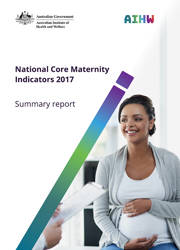Summary
In 2017, 301,095 women gave birth in Australia. Maternity services in Australia are provided by 8 state and territory health departments and a number of private providers. Each state and territory has differing care provision systems and care available to pregnant women and their babies. National Core Maternity Indicators (NCMIs) provide information on measures of clinical activity and outcomes in relation to maternity care across Australia.
The purpose of the indicators is to assist in improving the quality of maternity services in Australia by establishing baseline data for monitoring and evaluating practice change.
There are 12 indicators that cover data for the majority of women who gave birth in Australia in 2017 and are grouped into 3 broad topic areas:
- antenatal (during pregnancy) period,
- labour and birth, and
- birth outcomes.
Introduction
Antenatal period indicators
Labour and birth indicators
Birth outcome indicators
Data source and methods
More information
End matter: Acknowledgments; References



